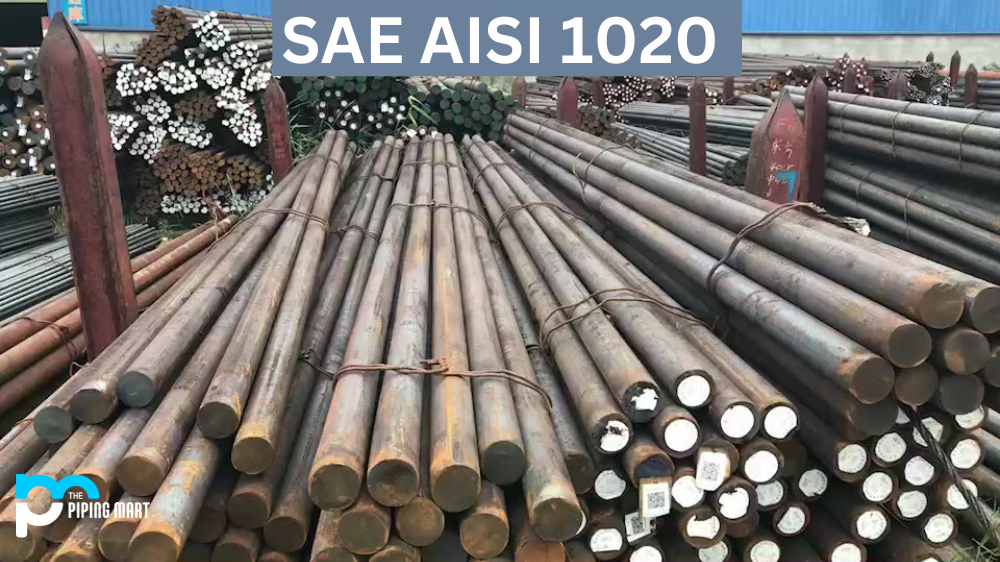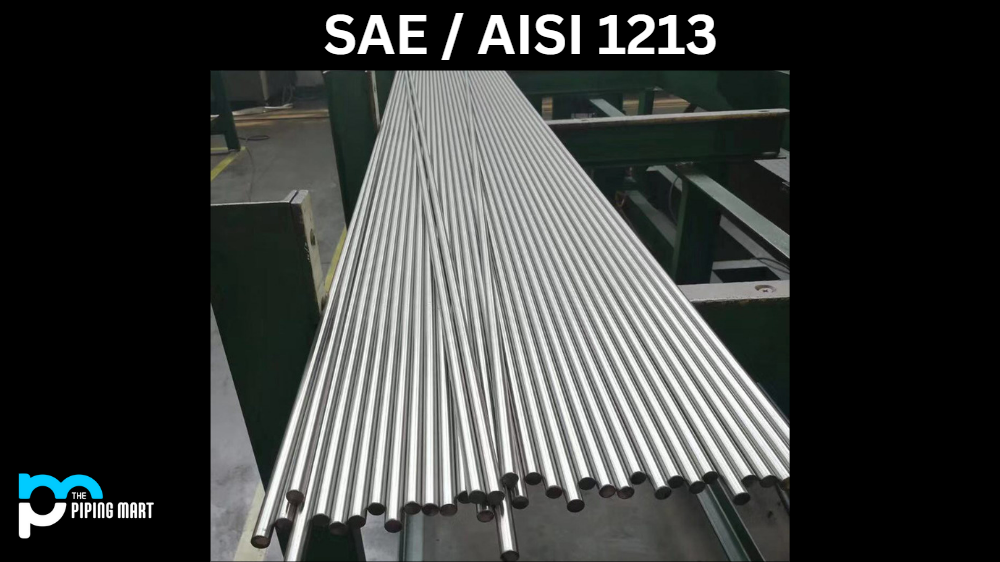SAE/AISI 1020 is low-carbon steel with various valuable properties. It has a good balance of strength, flexibility, and toughness and can be easily machined or welded. To get the most out of this versatile material, it’s important to understand its composition, chemical properties, mechanical properties, physical properties, uses, corrosion resistance, heat resistance, heat treatment options, and machining processes. Let’s dive into what makes SAE/AISI 1020 so unique.
AISI 1020 Composition
SAE/AISI 1020 consists primarily of carbon, small amounts of manganese, and possible traces of phosphorus and sulfur. The exact composition varies from manufacturer to manufacturer but generally ranges between 0.17% – 0.23% carbon by weight.
| Element | Content |
|---|---|
| Carbon, C | 0.17 – 0.230 % |
| Iron, Fe | 99.08 – 99.53 % |
| Manganese, Mn | 0.30 – 0.60 % |
| Phosphorous, P | ≤ 0.040 % |
| Sulfur, S | ≤ 0.050 % |
AISI 1020 Chemical Properties
SAE/AISI 1020 has excellent weldability and machinability characteristics due to its relatively low carbon content compared to other materials in its class. As a result, it can be easily cut or formed without losing any of its strength or toughness in the process. These elements also make it highly resistant to corrosion in many environments.
AISI 1020 Mechanical Properties
The mechanical properties of SAE/AISI 1020 are impressive for such a low-carbon material. Its tensile strength ranges between 415-500MPa, while its yield strength is around 345MPa with an elongation rate of 22%. It also has an impact energy value at room temperature of around 28J at -40°C, making it ideal for cold weather applications where other materials would struggle to perform adequately. Additionally, it exhibits good fatigue resistance, which makes it suitable for applications where parts will need to be used under repetitive loading conditions over time without failing prematurely.
| Mechanical Properties | Metric | Imperial |
|---|---|---|
| Hardness, Brinell | 111 | 111 |
| Hardness, Knoop (Converted from Brinell hardness) | 129 | 129 |
| Hardness, Rockwell B(Converted from Brinell hardness) | 64 | 64 |
| Hardness, Vickers (Converted from Brinell hardness) | 115 | 115 |
| Tensile Strength, Ultimate | 394.72 MPa | 57249 psi |
| Tensile Strength, Yield | 294.74 MPa | 42748 psi |
| Elongation at Break (in 50 mm) | 36.5 % | 36.5 % |
| Reduction of Area | 66.0 % | 66.0 % |
| Modulus of Elasticity (Typical for steel) | 200 GPa | 29000 ksi |
| Bulk Modulus (Typical for steel) | 140 GPa | 20300 ksi |
| Poissons Ratio | 0.290 | 0.290 |
| Charpy Impact | ||
| @Temperature -30.0 °C/-22.0 °F | 16.9 J | 12.5 ft-lb |
| @Temperature -18.0 °C/-0.400 °F | 18.0 J | 13.3 ft-lb |
| @Temperature -3.00 °C/26.6 °F | 20.0 J | 14.8 ft-lb |
| @Temperature 10.0 °C/50.0 °F | 24.0 J | 17.7 ft-lb |
| @Temperature 38.0 °C/100 °F | 41.0 J | 30.2 ft-lb |
| @Temperature 65.0 °C/149 °F | 54.0 J | 39.8 ft-lb |
| @Temperature 95.0 °C/203 °F | 61.0 J | 45.0 ft-lb |
| @Temperature 150 °C/302 °F | 68.0 J | 50.2 ft-lb |
| Izod Impact | 125 J | 92.2 ft-lb |
| Shear Modulus (Typical for steel) | 80.0 GPa | 11600 ksi |
AISI 1020 Heat Treatment
SAE/AISI 1020 can be hardened through a process called “heat treatment”, which involves heating the material to temperatures ranging from 815-845°C followed by cooling down slowly over several hours or days, depending on the desired outcome. This process helps increase both hardness and wear resistance while maintaining flexibility and toughness simultaneously, makings it ideal for applications that require parts that must be strong yet still flexible enough not to break easily under stress or pressure conditions.
AISI 1020 Equivalents
| AISI SAE ASTM 1020 steel equivalent material | |||||||||||
| US | Germany | China | Japan | ISO | |||||||
| Standard | AISI (UNS) | Standard | Grade | Standard | Grade (Material Number) | Standard | Grade | Standard | Grade | Standard | Grade |
| AISI SAE; ASTM A29/A29M |
1020 (G10200) | AMS | 5032D; 5045E; 5046 |
DIN EN 10083-2; DIN EN 10250-2 |
C22E (1.1151); C22 (1.0402) |
GB/T 699 | 20 steel | JIS G4051 | S20C | ||
AISI 1020 Physical Properties
AISI/SAE 1020 has many unique physical properties that make it ideal for various industrial uses. Its excellent toughness allows it to be easily machined, while its flexibility and relatively low strength limit the force needed for forming processes. It is also relatively low in cost compared to other steel grades, which makes it attractive for large-scale applications. With a tensile strength assessed at between 365 – 485 MPa, AISI/SAE 1020 displays good overall mechanical properties. As with all SAE/AISI steels, measures should be taken to ensure the correct heat treatment is conducted on this grade to maximize its potential. The combination of these distinctive physical attributes makes AISI/SAE 1020 an extremely versatile steel grade suitable for many purposes.
| Physical Properties | Metric | Imperial |
|---|---|---|
| Density | 7.87 g/cc | 0.284 lb/in³ |
AISI 1020 Uses
SAE / AISI 1020 is a popular carbon steel grade suitable for a variety of different applications. It is often used to make Axles, Shafts and other mechanical components due to its good weldability and machinability properties. It also has great flexibility, making it well-suited for shock loads and vibrational stress relief. Furthermore, SAE / AISI 1020 steel is used extensively in the food industry due to its non-toxic qualities and resistance to corrosion. Its corrosion resistance is especially beneficial when applied to the manufacturing of cooking utensils such as pots and pans. All in all, this economic steel grade can be put to use in a wide array of everyday applications that require good thermal and electrical conductivity.
AISI 1020 Corrosion Resistance
SAE / AISI 1020 is a relatively low-carbon steel that provides great flexibility in terms of construction. It has superior resistance to rust and corrosion, making it an ideal material for many applications. Its tensile strength of around 315 MPa helps in ensuring that structures built using this material are safe and stable. One of the main advantages of SAE / AISI 1020 is the superior corrosion resistance it offers compared to other steel alloys. This makes it suitable for use in environments with high moisture content, such as coastal regions. Additionally, its ability to fight against corrosion without requiring extra protection makes it popular among industries that handle contaminated chemicals or materials, such as petrochemical plants or oil refineries.
Heat Resistance
SAE/AISI 1020 steel is an incredibly reliable material for its exceptional heat resistance properties. Its hardness and strength make it the ideal material for components exposed to high temperatures. It’s also very resistant to deforming, warping, and cracking when heated, making it one of the most versatile alloys available for various industries across the board. This level of heat resistance also makes SAE/AISI 1020 steel highly sought after in the production of heavy machinery parts, sealing tools, pipes, structural frames and much more. The fact that this material can maintain its structural integrity even when exposed to intense heat levels is truly a marvel of modern engineering.
Heat Treatment
SAE / AISI 1020 steel’s heat treatment is generally simpler than other steels. It does not require a complex heating sequence and can be hardened through quenching and self-tempering cycles. The most common methods used to achieve the desired results involve solution annealing, normalizing, and tempering. Solution annealing involves heating the steel above its critical temperature followed by slow cooling in order to transform it into an austenitic microstructure. Normalizing further removes stresses caused by cold working before tempering increases the hardness of the component. Understanding how heat treatment can affect your components is key to getting the most out of your SAE / AISI 1020 steel.
Machining
Machining SAE/AISI 1020 steel can be an economical and efficient process due to its relatively low hardness and tensile strength. This makes it easy to cut when using traditional machining processes such as milling and drilling. At the same time, the low carbon content of this type of steel allows the material to easily accept additional treatments, such as heat treatment after machining is complete. Because machining SAE/AISI 1020 steel can be performed quickly, with less downtime associated with setup and tool changeover, this material is a cost-effective option for some production applications.
Welding
Welding SAE/AISI 1020 steel is a common welding procedure for many mechanical components and structures. It offers good machinability and good formability; makings welded joints more secure and rigid. The welding process is also quite simple, which means that the same joint can be formed with minimal effort and energy. This alloy offers better strength than some of the lower-grade steels while at the same time having a lower cost compared to higher-grade steels with similar strength levels. The welds hold up well to extreme temperatures and can be used in rough environments without corrosion or cracking due to their relatively good corrosion resistance. With its combination of good properties, cost-effectiveness and simplicity, it’s easy to see why SAE/AISI 1020 welding is so popular in the fabrication industry today.
Conclusion
All in all, SAE/AISI 1020 is an incredibly versatile material that can be used in countless industries due to its combination of beneficial chemical properties and mechanical attributes such as strength, ductility and toughness coupled with excellent weldability and machinability characteristics as well as good corrosion resistance when exposed to certain environments It is also capable of having different levels hardness depending on how it is treated which allows users to customize their parts according to their specific needs without compromising performance in any way making this an ideal choice for many applications where reliability is paramount. With all these advantages combined, we can see why SAE/AISI 1020 remains popular even today despite being one of the oldest materials! For those looking for a reliable material capable of withstanding tough conditions without breaking, look no further than SAE/AISI 1020!

Meet Bhavesh, a seasoned blogger with a wealth of knowledge and experience. From metal products manufacturing to retail, Bhavesh has a diverse background in various industries and is dedicated to sharing his insights and expertise with readers.




